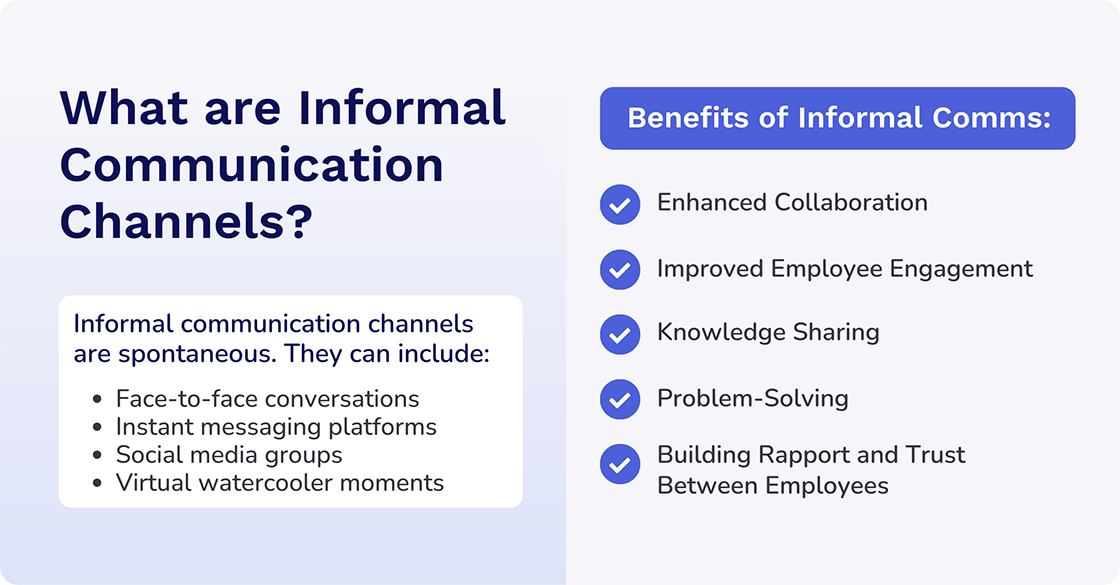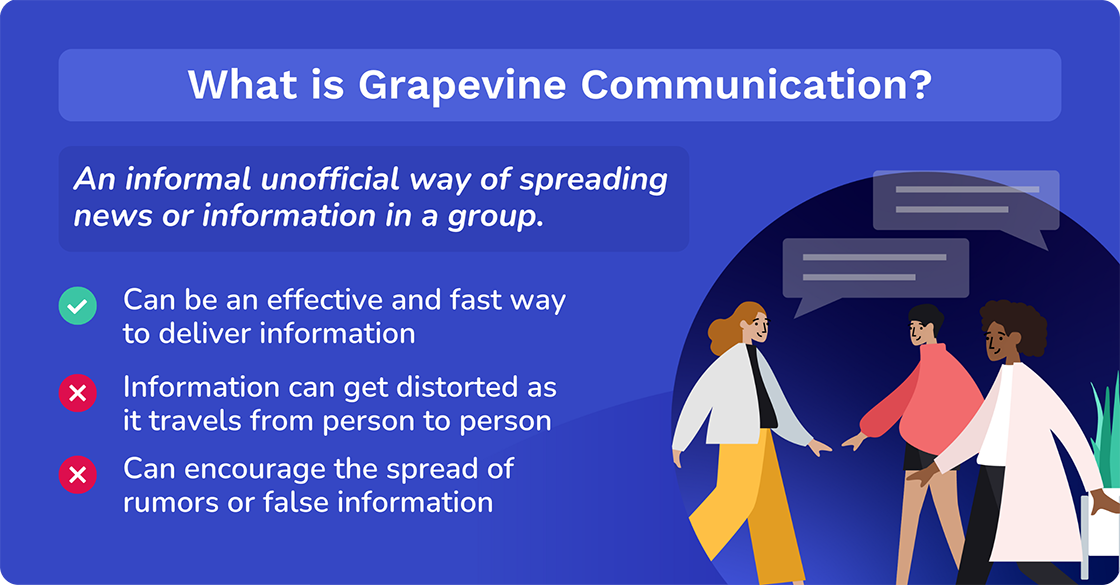Grapevine communication is quick and effective. It gets to employees instantly. But it isn’t a method of communication companies use. Why? We have all the answers.

.webp)
Effective internal communication is the backbone of every successful organization. Learn the ins and outs of internal communications with our research-backed white paper.
Access NowOrganizations are inherently social. People form groups, both formal and informal, and communication follows suit. This gives rise to grapevines, which are informal communication networks that exist within every organization.
In essence, grapevine communication refers to the informal, unofficial sharing of information between individuals, often through word of mouth. While it may seem like a convenient way to stay informed, grapevine messages are often based on rumors, hearsay, and gossip, making them unreliable and potentially inaccurate. As a result, it's essential to verify information through credible sources to ensure accuracy and avoid spreading misinformation.
While statistics about internal communication are quoted widely in reports on survey studies, grapevine communication doesn’t usually feature. There are, though, a few research reports on the topic.
A post published by the American Management Association (AMA), I Heard it Through the Grapevine, though a little dated (2019) is telling and worth quoting. Whilst we cannot rely on the stats quoted, it’s unlikely that they have changed much in the past four years.
“Research suggests that up to 70% of all organization communication comes through the grapevine, yet many senior leaders are unaware that it exists or how it operates. One study, in fact, found that while 92% of lower-level managers knew the grapevine was active, only 70% of upper-level managers knew about it. In the same study, 88% of supervisors said they understood that the absence of formal communication increased activity through informal channels — but only 54% of executives understood this correlation.”
AMA
As they say, the challenge is to understand how the grapevine works within your organization - then determine how you can influence it.
It is not a form of communication that you want to leverage. But you need to understand and manage it. This blog post will help you to do just this.
Grapevine communication is an informal form of communication. To understand grapevine communication fully, it’s important to identify which informal communication channels are effective in company internal communications. Unless you do this, you aren’t going to be able to manage grapevine communication effectively.
The most important element is that while formal communication channels including emails, reports, and meetings are crucial, informal communication plays a vital role in fostering a healthy and productive work environment.
Unlike organized internal communications, informal communication channels are spontaneous. They include:
Their role is quite different from those structured by internal communicators. But they have very definite benefits including:
And none of these has anything to do with grapevine communication!

There are a myriad of definitions of grapevine communication. For example, Webster’s defines it as "informal person-to-person means of circulating information or gossip." Collins defines it as an “informal unofficial way of spreading news.” The Cambridge American dictionary defines it as “an unofficial, informal way of getting information by hearing it from someone who heard it from someone else: I heard it through the grapevine that they fired him — is that true?”
The ubiquity of the grapevine is undeniable and it has a significant impact on how organizations function.
Prof. Keith Davis, a well known psychology professor who lectured at the University of South Carolina in the 1970s did substantial ongoing research on the topic. He hits the nail on the head!
“Grapevine arises from social interactions. It is as fickle, dynamic, and as varied as people are. It is the exercise of their freedom of speech and is a natural, normal activity.”
Keith Davis
Grapevine communication is a prime example of an informal communication channel. While not sanctioned by the organization, it can be surprisingly effective and fast in terms of delivery. The problem is that while information travels quickly through the grapevine, it often gets distorted or diluted along the way. Unlike formal channels that follow hierarchical structures, the grapevine cuts across them, spreading information through clusters and chains.
Rumors are a common feature of grapevine communication. When employees lack information or have a personal stake in a situation, they're more likely to be active participants in the grapevine, spreading or seeking information through this informal network. They share information because it’s what they want others to hear, not because it is necessarily true.
Let’s dig more deeply into the role of rumors in grapevine communication.

Rumors are a significant element in grapevine communication, but they are a double-edged sword. They spread information that typically has a negative impact. For this reason, management needs to develop strategies and use them positively if they can, which is a huge challenge.
A South University College of Business thesis by Gregory P. Priebe, The Mediating Effect of Grapevine Communication on Personality and Employee Commitment After a Merger or Acquisition Integration studies the relationship between organizational change behavior and grapevine communication.
He hits on some interesting points, quoting from several studies. For instance, he highlights that the “grapevine and rumor mills are unavoidable and unpreventable in organizational life.” However, “rumor mills and toxicity can be prevented or severely reduced if top management addresses change uncertainty with employees and resolve these uncertainties as quickly as possible.” But the reality is that about “70% of organizational communication happens at the grapevine level and that official communication from top leadership often comes far after rumors have become rooted.”
“This is also a dangerous platform because leaders who are actually aware but exhibited those negative characteristics (e.g., worry, distrust, weak commitment) are forced to give way to incorrectly trusted individuals who can generate incorrect information that can rapidly spread through the grapevine and spark rumor mills.”
Gregory P. Preibe
However, in his thesis, Priebe also highlights examples that are pro grapevine communication. He provides evidence that if personal rumor mills are removed from the communication channel, grapevine communication can be a very useful tool. For example “when monitored, the grapevine can provide early warning signals of employee unrest or identify pending problems or concerns generated by rumors.”
Ultimately, he shows that it is important to prevent rumors and general misinformation, particularly when it comes to mergers and acquisition.
Gallagher’s State of the Sector 2023/2024 survey found that a current trend in communication channels includes informal collaboration tools. Those that respondents rated the best ranged from chat tools to text messages, one-to-ones, informal get-togethers and “brown bag sessions”. Of the broadcast channels they mention as effective, only emails (sent to colleagues) and text messages could potentially be used for grapevine communication.
This is because grapevine communication thrives in the informal spaces of an organization. It enables information to skip official channels and flow freely through conversations, chats, and whispers. That's how the grapevine works.
It creates a rapid network that can spread news quickly. But accuracy suffers as details get twisted or embellished along the way. Rumors often take root in grapevine communication, This highlights the importance of clear, official communication to keep the grapevine factual and the organization humming.
Here’s what gets the rumor mill churning:

We have said that grapevine communication spreads information through clusters and chains. Think of it like this. You have gossip, rumors, and secrets that are whispered down a line or chain. Or you have news based on these ideas bouncing between friend groups or clusters.
When we define types of grapevine communication types, we can do so by structure, or by purpose or outcome. However, it’s important to remember that different types of grapevine communication can flow upwards (employees to management), downwards (management to employees), or horizontally (between colleagues). Also, the accuracy of information traveling through the grapevine is highly variable and can deteriorate significantly as it spreads.
It is also important to remember that these categories aren't mutually exclusive. A single grapevine communication event might exhibit characteristics of multiple types.
Technology has significantly altered the landscape of grapevine communication, enhancing both its speed and reach. Digital tools such as instant messaging apps, social media platforms, and email have revolutionized how information is shared within organizations, making it almost instantaneous. Employees who might not have been part of informal networks due to physical distance or social barriers can now participate in every form of communication. This inclusivity ensures that a broader range of voices is heard, and information is not restricted to a select few.
According to The Harris Poll and Grammarly 2024 State of Business Communication report, companies are communicating in more places than ever before. For example, 84% of business leaders and 70% of knowledge workers have communicated across more channels in the past 12 months.
“The most common channels are email, virtual and in person meetings, and text-based chat, accounting for half the time spent communicating each week. This includes over nine hours, or approximately 23% of the workweek, spent engaging with others through collaboration tools.”
Grammarly
While they aren’t factoring in grapevine communication, it could be part of the picture.
By analyzing communication patterns and content through digital platforms, organizations can identify emerging issues and address them proactively. This monitoring can help mitigate the negative effects of rumors and ensure accurate information dissemination. But you need to focus specifically on grapevine communication to see where the organization is affected and where it is going.
Here are six key strategies to manage grapevine communication effectively.
By maintaining open communication channels and providing employees with accurate and timely information, organizations can reduce reliance on the grapevine for news.
Don't ignore rumors. Address them directly with clear and factual information to prevent them from spreading further.
Leverage social media and other internal communication platforms to share positive news and company updates directly with employees.
Create channels for employees to voice their concerns and ideas openly, reducing the need for them to resort to the grapevine.
Consistent updates on company news, changes, and policies through newsletters, emails, or meetings can keep employees well-informed, reducing speculation and the spread of misinformation.
Foster a culture of trust within the organization where employees feel confident that the information they receive from leadership is accurate and comprehensive. Trust can diminish the appeal of unofficial channels for information.

Cerkl Broadcast aims to streamline communication processes, ensure targeted messaging, and increase employee engagement, ultimately leading to a more efficient and effective communication environment.
It also reduces reliance on the Grapevine!
By providing a reliable, timely source of information, Cerkl Broadcast can help reduce reliance on the grapevine for news and updates. This promotes the spread of accurate information and minimizes confusion.
At the end of the day, you need to assess your internal comms strategy. This begins with a thorough analysis of your current internal communications program. We have something to help you.
What is the difference between grapevine and rumor? The grapevine comprises a network of informal communication, while a rumor is a specific piece of unverified information spread through that network. The grapevine can carry rumors, but also news, gossip, or just general chatter.
What is the best example of company grapevine communication? A good example of company grapevine communication is when employees hear about a promotion through colleagues before the official announcement. This shows information is flowing freely, but it's important for official channels to confirm details quickly to avoid confusion.
What is the purpose of the grapevine in communication? The grapevine serves several purposes. It can fill information gaps when formal communication is lacking, and it can reveal employee morale and sentiment. It's important for leaders to be aware of the grapevine to address concerns and ensure accurate information is circulating.